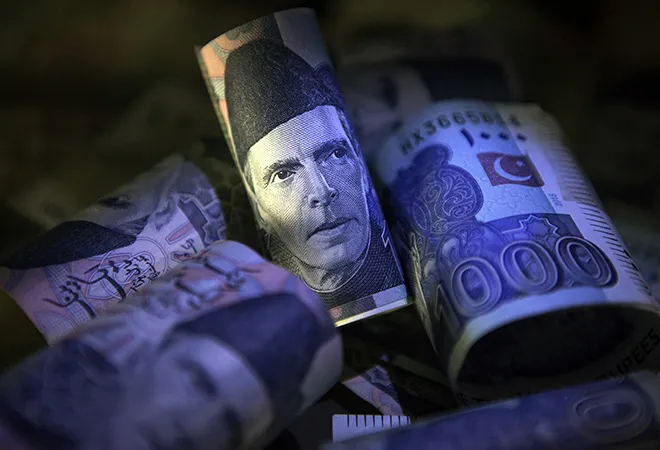
For some years now, Pakistan’s economy has been in the throes of a slow meltdown. Like the previous two budgets, the third budget presented by the Imran Khan government on 12 June was supposed to be make or break, and quite like the preceding budgets, the current budget too will neither completely break nor make Pakistan; instead, Pakistan’s economy will remain in what is best described as suspended animation, with no clear direction, and tottering from one financial crisis to another, constantly in search of one bailout after another.
In many ways, the entire budget exercise was meaningless. Within a day of the budget being presented, the architect of the budget — de facto finance minister Hafeez Shaikh — declared that there was nothing sacrosanct about the numbers projected in the annual financial statement. According to Shaikh, the budget was “an evolving document that can be adjusted around the clock in line with ground realities.” In other words, he was admitting that most numbers in the budget were aspirational and therefore unlikely. But if the federal budget calculations and estimates are a pie in the sky, so too would be the budgets of the provinces which depend on transfer from the federal government for around 90% of their resources.
Within a day of the budget being presented, the architect of the budget — de facto finance minister Hafeez Shaikh — declared that there was nothing sacrosanct about the numbers projected in the annual financial statement.
The deep scepticism surrounding the Pakistan budget stems from grossly unreal projections — the Annual Development Plan that lays out the macroeconomic framework on which the budget is based estimates GDP to grow at 2.1% during Financial Year (FY) 2020-21 even though the multilateral financial institutions like IMF and World Bank expect growth to be in negative territory for the second year running. With the foundation of the budget based on fiction, or if you will hope, everything else — revenue, debt, inflation — becomes dodgy, and nothing more than wishful thinking. Even so, the numbers in the budget documents give an idea of the precarious and parlous state of the Pakistan economy, and its tattered fiscal condition.
Many Pakistani analysts have pointed out that this budget has been made with an eye on the IMF and not so much to kickstart the economy in Pakistan. Pakistan desperately needs to remain in the Enhanced Fund Facility (EFF) programme of the IMF, without which it will lose the support of other multilateral financial institutions like World Bank and ADB. Therefore, it is entirely understandable that the diktats of the IMF are being followed, at least on paper. To give a small sample: in April, the IMF had projected that Pakistan’s Federal Board of Revenue (FBR) would collect taxes of PKR 5.1 trillion in FY21. The same document had put defence expenditure at PKR 1.33 trillion and the petroleum levy at PKR 489 billion. Reports in the Pakistani media revealed that the IMF had insisted on a freeze on salaries and even pensions as a condition for reviving the EFF which was put in abeyance because of the COVID-19 crisis. The budget more or less conforms to these estimates — FBR revenue is PKR 4.95 trillion, defence expenditure is PKR 1.29 trillion, the petroleum levy is PKR 450 billion, and there has been no increase in salaries of government staff. Once the budget passes, the Pakistanis, as is their wont, will violate all these commitments to the IMF which as per its wont, give them waiver after waiver.
The budget more or less conforms to these estimates — Federal Board of Revenue (FBR) revenue is PKR 4.95 trillion, defence expenditure is PKR 1.29 trillion, the petroleum levy is PKR 450 billion, and there has been no increase in salaries of government staff.
The budget numbers are in any case so over the top that no one can take them seriously. The tax collection target set for the FBR is PKR 4.96 trillion which is around 27% higher than the PKR 3.91 trillion taxes collected in FY20. With a projected GDP growth of 2.1%, inflation of 6.5% and some additional efforts to collect taxes, the maximum increase in tax collection that can be expected is around 10-12%. This means approximately PKR 4.25 trillion which is PKR 700 billion less than the targeted collection. And this is assuming that the economy will grow by 2.1% which no one other than the Pakistanis expect to happen.
Until recently the Pakistanis kept insisting that the GDP growth in FY19 was around 3.3%. But the latest data released by Pakistan’s National Accounts Committee puts the growth in the first year of the Imran Khan government at 1.9%. In the second year, i.e. FY20 the GDP growth has been put at -0.38%. With the COVID-19 crisis far from over, to expect Pakistan’s economy to grow by 2.1% in FY21 is nothing but delusional. Chances are therefore that the FBR taxes will hover around the PKR 4 trillion mark, which means that over the last four years, the tax collections by FBR have been virtually static even as expenditures have been increasing. Naturally, this means that the fiscal deficits are going quite haywire. In FY19 the fiscal deficit was 8.9% of GDP (the Pakistanis told IMF it will be 7.2%), in FY20 it is expected to be around 9.4% (against a budgeted 7%) and in FY21 there are some economists who believe that it will be in double digits though the budget documents put it at 7%.
With the COVID-19 crisis far from over, to expect Pakistan’s economy to grow by 2.1% in FY21 is nothing but delusional.
The high fiscal deficits means that Pakistan is facing a virtual debt trap situation. Some of this is reflected in the ever-rising bill on account of debt servicing. In FY20, the debt servicing was PKR 2.7 trillion as against a net federal revenue (the federal government’s revenue after taking out the share of the provinces) of PKR 3.1 trillion. This means about 87% of the federal government’s revenue was spent on debt servicing. In the current year, debt servicing is estimated to be PKR 2.9 trillion against a net federal revenue of PKR 3.7 trillion (which is grossly inflated as described below). Even if by some miracle Pakistan manages to collect the targeted tax revenue, the debt servicing will take away around 80% of the federal government revenue.
Add to this defence expenditure which in FY20 was PKR 1.23 trillion (excluding defence pensions) and PKR 1.59 (including defence pensions) which accounted for 40% of net federal revenue (without defence pensions) and about 50% (with defence pensions). This year, defence budget has been ramped up to PKR 1.29 trillion (without defence pensions) and PKR 1.66 trillion (with defence pensions) which is 35% and 45% respectively of the net federal revenue.
Cut through the clap-trap, Pakistan is broke because it isn’t able to generate enough resources and has to borrow to even to meet part of its defence budget, and this if we go by the far fetched numbers churned out by Pakistan’s economic spin doctors.
At the risk of being repetitive, the ratios of defence expenditure to net federal revenue will be much higher given that the federal revenue will be far lower than is being projected. The bottom line is that the bottom is falling off Pakistan’s finances and the state is over-leveraged. Cut through the clap-trap, Pakistan is broke because it isn’t able to generate enough resources and has to borrow to even to meet part of its defence budget, and this if we go by the far fetched numbers churned out by Pakistan’s economic spin doctors. If more realistic numbers were taken into account, then it would mean that virtually the entire defence budget is met from borrowings, as is the entire budget for running rest of the government.
Talking about rest of the government, according to the budget for FY21, the entire budget for running the civilian government will cost the exchequer PKR 476 billion. As compared to this, the pension bill (defence plus civilian) alone is PKR 470 billion, and going by past years record, even this is an underestimate. What is worse, the financial squeeze means that the government has absolutely no fiscal space left for any kind of social welfare schemes. In FY21, the government has increased the housing budget from PKR 2.5 billion to over PKR 35 billion. This is largely on account of the Naya Pakistan housing scheme in which accomplices of Imran Khan are going to be awarded fat contracts to build low cost housing for the people. But analysts believe this scheme is going to be a non-starter. On health, the government has doubled the expenditure from PKR 12 billion to over PKR 25 billion. This is at a time when the COVID-19 crisis is still unfolding, a crisis in which the Imran Khan government has been found to be blundering along with no clue and no direction on how to mitigate the health crisis. Even so, the enhanced budget is only 0.4% of the total budget expenditure in FY21. The education budget fares only marginally better. It has been increased from PKR 81 billion to PKR 83 billion and constitutes about 1.3% of total expenditure. As a comparison, debt servicing accounts for 47% of total current expenditure in the budget.
What is worse, the financial squeeze means that the government has absolutely no fiscal space left for any kind of social welfare schemes.
Admittedly, health and education have been devolved to the provinces and therefore the role of the federal government is only to be marginal in these activities. But the problem is that under pressure of the military establishment, the ‘selected’ government is trying to reduce the funds transferred to the provinces under the National Finance Commission award. If this is done, as is quite likely given the rather effete response of the Pakistani political class to arm twisting by the military, the provinces will be left with no funds for providing social goods like health and education to the people.
Despite all the window dressing, the budget for FY21 makes it quite clear that Pakistan is sliding inexorably towards a financial abyss. Without deep structural reform, which includes reducing the size of government and curtailing the expenses on the overbearing and overfed holy cow — the military — Pakistan will not be able to get its finances under control. Dependence on foreign sources — China in particular — will not pull Pakistan’s chestnuts out of the fire; quite to the contrary, if the Chinese investments and the resulting financial obligations, including mounting debt, is any thing to go by, Pakistan is only going deeper in the hock to China.
The views expressed above belong to the author(s). ORF research and analyses now available on Telegram! Click here to access our curated content — blogs, longforms and interviews.




 PREV
PREV


